Using Honey as an Adjunct in Beer Brewing
Published: July 20, 2025 at 11:04:45 AM UTC
The tradition of adding honey to beer brewing dates back centuries. It's now gaining popularity again. This method not only brings unique tastes to the brew but also boosts fermentation. The National Honey Board highlights honey's versatility in beer brewing. It can be used in many styles, opening up creative avenues for brewers. Its distinct taste and fermentation benefits make it a favorite among brewers.
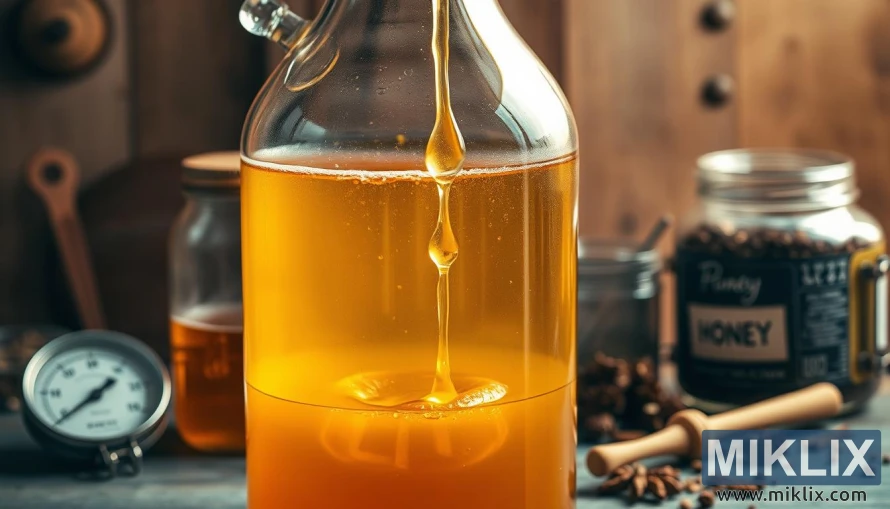
Key Takeaways
- The use of honey in beer brewing is an ancient practice with modern applications.
- Honey adds unique flavors and enhances fermentation in beer.
- The National Honey Board provides valuable insights into the applications and benefits of using honey in brewing.
- Honey can be used in various beer styles, opening up creative possibilities.
- The distinct flavor profile of honey makes it a popular choice among brewers.
Understanding Honey's Role in Beer Brewing
Honey is a versatile ingredient in beer brewing, opening up a world of possibilities for brewers. Its high fermentability significantly impacts the beer's character, adding complexity and quality. This makes honey a valuable addition to brewing.
Honey contains about 82.4% carbohydrates, with 90% to 98% being fermentable. This high fermentability means it can add fermentable sugars to the brew. This can increase the alcohol content and alter the beer's flavor profile.
Using honey as an adjunct can enhance the beer's aroma and flavor. It introduces notes that range from floral to fruity, depending on the honey type. This allows brewers to experiment with different honey varieties to achieve the desired flavor.
- Honey can contribute to a smoother, more complex flavor profile.
- The fermentability of honey can impact the beer's alcohol content and overall character.
- Different types of honey can introduce a range of flavors and aromas to the beer.
Understanding honey's role in beer brewing is key for brewers wanting to try new recipes and techniques. By incorporating honey, brewers can create unique and flavorful beers. These beers can stand out in the market.
Historical Context of Honey in Brewing
Honey has been a cornerstone in brewing for millennia, tracing back to ancient civilizations. Its use in fermented drinks began with mead, a honey-based beverage. This drink was enjoyed across various cultures.
Honey's role in brewing extends beyond being a primary ingredient. It was also used to craft unique flavors and boost beverage fermentability. Ancient brewers found that mixing honey with other ingredients could yield a vast array of tastes and strengths.
- The production of mead, a beverage made entirely from honey, which was consumed in ancient cultures such as the Greeks, Romans, and Vikings.
- The use of honey in ancient beers, where it was added to enhance flavor and fermentation.
- The role of honey in traditional brewing practices, where it was often used in conjunction with other ingredients to create unique beverages.
Exploring honey's historical role in brewing offers brewers a profound appreciation for its versatility. By studying ancient uses of honey, brewers can uncover new methods and recipes. This approach allows for the integration of this ancient ingredient into modern brewing practices.
Types of Honey Suitable for Brewing
The world of honey is vast, with over 300 unique types in the United States. Each type has its own flavor profile and characteristics. Choosing the right one can be challenging.
Different honeys can greatly affect a beer's flavor and character. Clover honey brings mild, floral notes, while buckwheat honey offers a robust, molasses-like taste. Each variety adds a unique element to the brewing process.
- Clover honey, known for its mild flavor and versatility
- Buckwheat honey, which adds a robust, earthy flavor
- Manuka honey, prized for its unique, slightly bitter flavor profile
- Wildflower honey, which offers a complex, floral flavor
- Acacia honey, with its delicate, floral notes
It's essential to understand the differences between these honeys. This knowledge helps brewers pick the perfect honey for their beer. By doing so, they can create a unique and delicious brew.
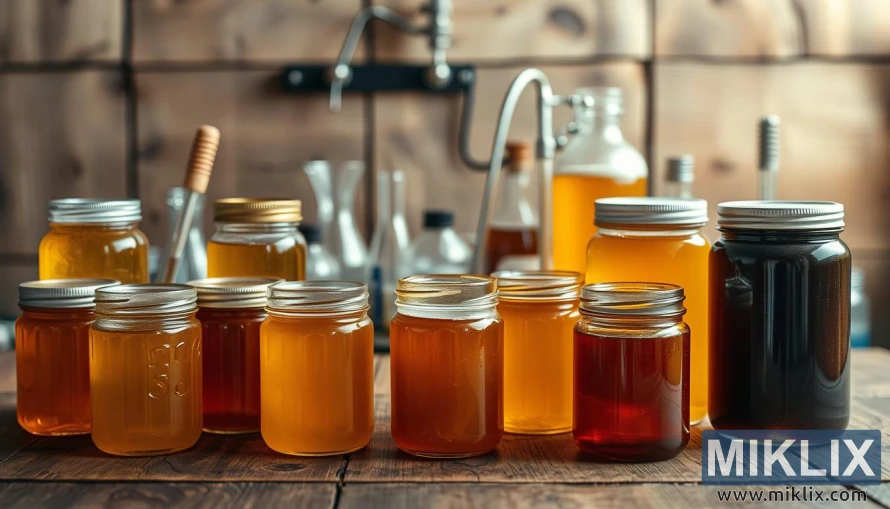
How Honey Affects Beer Character
Honey's unique composition makes it a valuable addition to beer brewing, significantly impacting the beer's character. Its carbohydrates are over 95% fermentable. This means adding honey early in brewing results in a product with no residual sweetness.
The type of honey used greatly influences the beer's flavor and aroma. For instance, a light, floral honey can introduce a subtle sweetness. On the other hand, a darker, more robust honey can add a rich, complex flavor profile.
Honey's influence on beer character extends beyond flavor and aroma. It can also alter the beer's mouthfeel and finish. By choosing the right type and amount of honey, brewers can craft a unique beer that highlights the honey's characteristics.
To achieve the desired outcome, brewers must consider when to add honey. Different stages of brewing can lead to varying levels of flavor and aroma. Understanding honey's impact on beer character is key to unlocking its full brewing possibilities.
Calculating Honey Additions in Your Recipe
When brewing with honey, the right amount is essential. It enhances your beer's character without overwhelming it. The amount needed varies based on the beer type and desired flavor.
The National Honey Board recommends adding honey at 3 to 10 percent of total fermentables. This ensures a subtle, floral taste and a delicate aroma. For instance, with 5 pounds of malt extract, add between 0.15 and 0.5 pounds of honey.
To figure out honey addition, first calculate your total fermentables. This includes malt extract, grains, and other fermentable ingredients. Then, choose the honey percentage you want, based on your flavor goals. For a stronger honey taste, use the higher end of the range.
- Determine your total fermentables in pounds.
- Decide on the percentage of honey to add (between 3% and 10%).
- Calculate the amount of honey to add based on your total fermentables.
Brewing with honey is an art that requires experimentation. Start with a small batch and adjust the honey amount in future brews based on taste preferences.
Best Beer Styles for Honey Addition
Different beer styles can greatly benefit from the addition of honey, creating complex and intriguing flavors. Honey's unique flavor profile can complement a range of ingredients, making it a versatile adjunct in beer brewing.
When brewing with honey, the type of beer style is key for achieving the desired flavor profile. Here are some of the best beer styles for honey addition:
- Pale Ales: Honey's subtle sweetness can enhance the hoppy flavors in pale ales, creating a balanced taste experience.
- Stouts and Porters: The robust complexity of stouts and porters can be complemented by the rich, malty flavors that honey provides.
- Wheat Beers: Honey can add a fruity and floral dimension to wheat beers, enriching their refreshing qualities.
- Sour Beers: The sweetness of honey can balance the tartness in sour beers, creating a harmonious flavor profile.
Brewing with honey opens up a wide range of creative possibilities. By understanding the best pairings for honey in different beer styles, brewers can craft unique and delicious beers that stand out.
For instance, a pale ale brewed with clover honey can have a delicate floral note. On the other hand, a stout brewed with buckwheat honey can have a robust, earthy flavor. The key is to experiment with different types of honey and beer styles to find the perfect combination.
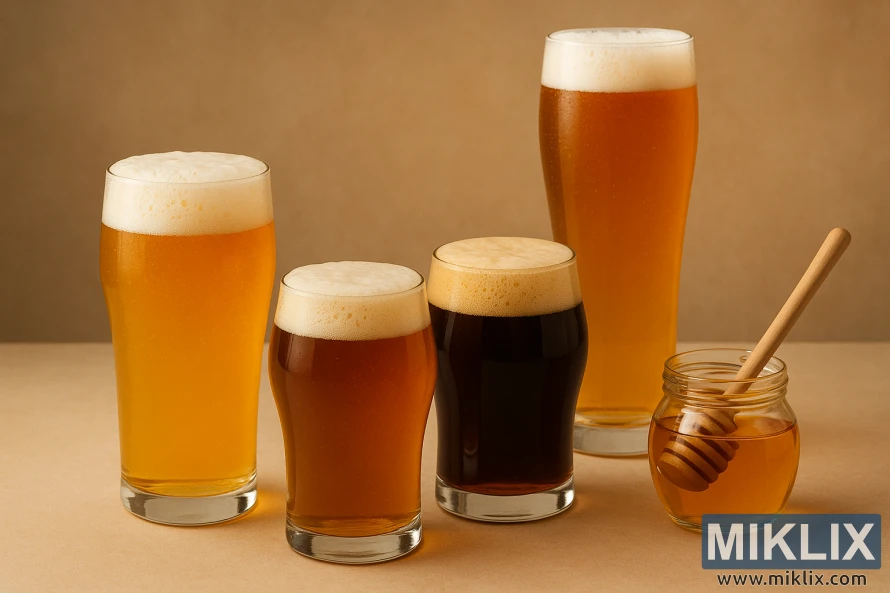
When to Add Honey During the Brewing Process
The timing of honey addition is a critical factor in beer brewing, influencing the final flavor and aroma. Brewers can add honey at various stages, from the boil to fermentation, each with its benefits and drawbacks.
Adding honey during the boil can help sterilize it, reducing the risk of contamination. Yet, boiling honey for too long can result in the loss of its delicate flavor and aroma compounds. A shorter boil time or adding honey towards the end of the boil can mitigate this issue.
Another approach is to add honey during fermentation. This method allows the yeast to ferment the honey's sugars, potentially creating a cleaner honey flavor in the finished beer. The timing of honey addition during fermentation can vary, with some brewers adding it during the primary fermentation phase and others during secondary fermentation.
- Adding honey at the beginning of fermentation can contribute to a more vigorous fermentation.
- Adding honey towards the end of fermentation can help preserve its flavor and aroma.
- The choice of when to add honey depends on the brewer's goals for the beer's flavor profile.
Understanding the impact of honey addition timing on the brewing process is key to achieving the desired outcome. By carefully considering when to add honey, brewers can create complex and unique beer styles that showcase the characteristics of this versatile ingredient.
Preparing Honey for Brewing Use
Preparing honey for brewing requires several key steps that can greatly influence the final beer. Honey, a natural product, varies in purity and moisture content. It needs careful handling to blend seamlessly into the beer.
Pasteurizing honey is a primary consideration. This involves heating it to a temperature that kills bacteria or wild yeast. It's essential to prevent off-flavors or contamination in the beer. Yet, pasteurization can alter the honey's flavor and aroma, potentially diminishing its impact on the beer's character.
Another method is adding honey directly to the boil. This simplifies the brewing process by avoiding a separate pasteurization step. The boiling wort can sterilize the honey, killing any bacteria or yeast. The timing of honey addition varies based on brewer preference and beer style.
The way honey is handled and stored before brewing also affects the final product. It should be kept in a clean, dry place to avoid contamination. Choosing high-quality honey, free from additives and with a consistent flavor, is also critical.
- Select high-quality honey that is pure and has the desired flavor characteristics.
- Consider pasteurizing the honey to eliminate the risk of contamination, or add it directly to the boil.
- Store honey in a clean, dry environment to prevent spoilage.
By meticulously preparing honey for brewing, brewers can ensure it enhances the beer's flavor and character. This avoids introducing unwanted complexities.
Common Mistakes When Brewing with Honey
Honey brewing is a nuanced art that requires attention to detail to avoid common pitfalls. Brewers who incorporate honey into their recipes must be aware of the mistakes that can affect the quality and character of their beer.
One of the most common mistakes is adding too much honey to the brew. While honey can enhance the flavor and complexity of beer, excessive amounts can lead to an unbalanced taste and potentially affect fermentation.
- Not pasteurizing the honey before adding it to the brew, which can introduce unwanted bacteria or yeast.
- Failing to consider the impact of honey on fermentation, potentially leading to over-attenuation or other fermentation issues.
- Not adjusting the recipe to account for the sugars and other compounds present in the honey.
By understanding these common mistakes, brewers can take steps to avoid them and produce high-quality beers that showcase the unique characteristics of honey.
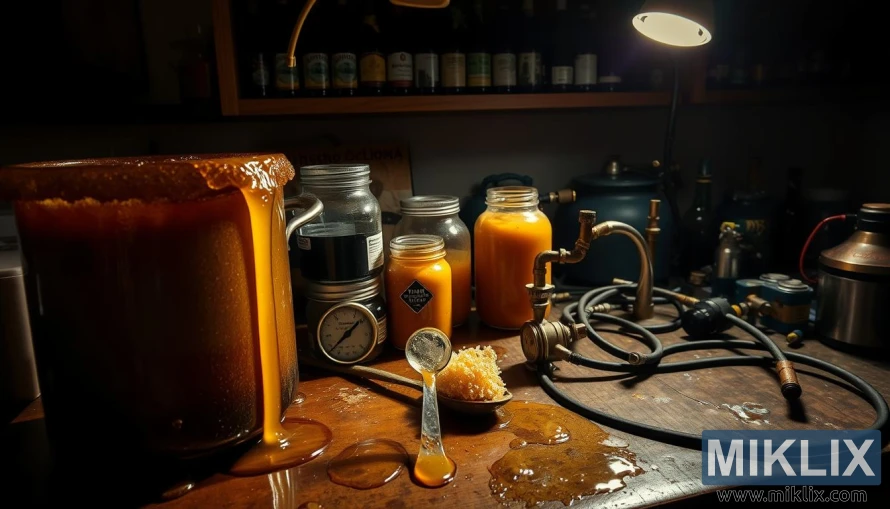
Equipment Needed for Honey Addition
To add honey to your beer, you'll need specific brewing tools. Key items include a hydrometer, thermometer, and equipment for keeping things clean.
A hydrometer is essential for checking your wort's specific gravity before and after fermentation. It helps gauge the alcohol content and confirms fermentation is on track. When using honey, it's vital to watch the gravity closely, as honey can alter fermentation.
A thermometer is also critical, as it lets you control fermentation temperature. Yeast works best at certain temperatures, and with honey, keeping it right is key for the perfect flavor.
Keeping everything clean is also vital when brewing with honey. Contamination can cause bad flavors and spoilage. Make sure all your gear is sanitized before use to ensure a top-notch beer.
- Hydrometer for measuring specific gravity
- Thermometer for temperature control
- Sanitization equipment for maintaining a clean environment
With the right tools, brewers can successfully add honey to their beer recipes. This leads to the desired flavors and outcomes.
Impact on Fermentation and Yeast Selection
Honey's role in fermentation is complex, providing a distinct nutrient mix for yeast. When brewing with honey, grasping its effects on fermentation is key.
Honey, mainly fructose and glucose, is quickly consumed by yeast. This can speed up fermentation compared to maltose-based ingredients. Yet, the fermentation pace can also vary based on honey type, due to differences in nutrients and inhibitors.
Choosing the right yeast is vital when brewing with honey. Opt for yeast strains that handle high alcohol well and thrive in the right temperature range. Some yeast can enhance honey's flavors, while others might introduce unwanted notes.
To optimize fermentation with honey:
- Choose a yeast strain that complements the flavor profile you're aiming for.
- Monitor fermentation temperatures closely, as honey can ferment more vigorously.
- Consider the nutrient profile of your honey and supplement if necessary.
Understanding honey's fermentation impact and making smart yeast choices can greatly improve your beer's quality. By harnessing honey's unique qualities and picking the right yeast, brewers can craft complex, top-tier beers that highlight both ingredients' best features.
Aging and Storage Considerations
The aging and storage of honey beer are critical for maintaining its quality and unique flavor. The type and amount of honey used can influence the flavor profile, which evolves over time. Proper storage conditions are key to preserving the intended flavor and aroma.
Several factors influence how honey beer ages. The beer's strength, the honey type, and brewing techniques all play a role. Generally, honey beers age like other beers, but their unique characteristics may need special attention.
- Store honey beer in a cool, dark place to slow down the aging process.
- Keep the beer away from direct sunlight and heat sources.
- Maintain a consistent refrigerator temperature around 40°F to 50°F (4°C to 10°C).
Aging can soften the flavors of honey beer, allowing them to blend together. The optimal aging time varies by beer style and brewer's goals. Some honey beers are best consumed fresh, while others improve with age.
For brewers aiming to age their honey beer, monitoring its condition is vital. Regular checks can spot issues like over-oxidation or contamination. This ensures the beer stays in top condition.
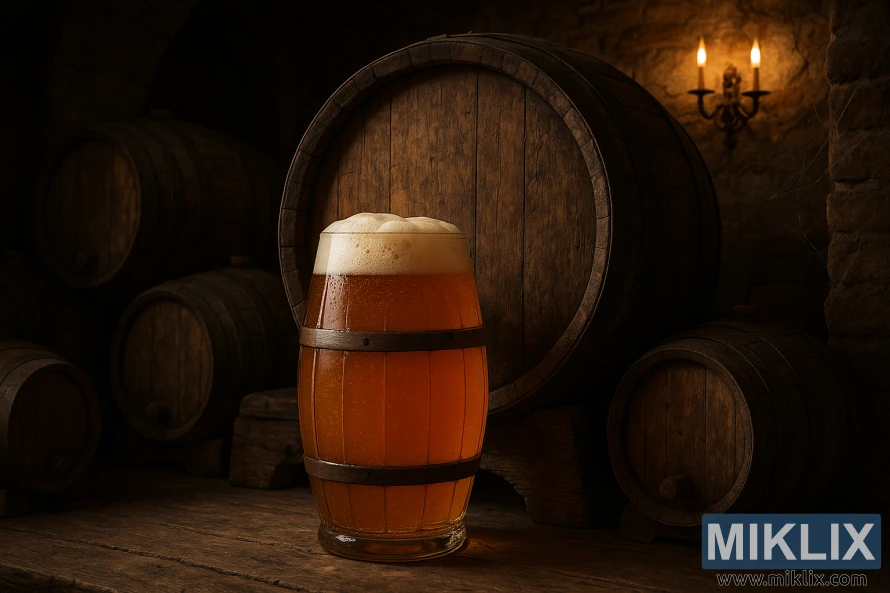
Troubleshooting Honey-Based Brews
When brewing with honey, several issues can arise, but understanding how to troubleshoot them can make all the difference. Honey adds a unique dimension to beer, but it also introduces complexities that can affect fermentation, flavor, and overall stability.
One of the primary concerns when brewing with honey is fermentation. Honey can be a challenging sugar source for yeast due to its composition, potentially leading to sluggish or stuck fermentations. To mitigate this, brewers should ensure that their yeast selection is appropriate for the honey variety used and that the fermentation conditions are optimal.
Flavor imbalances are another common issue. Honey can contribute a wide range of flavors depending on its type, from floral to dark and robust. If not balanced correctly, these flavors can overpower the beer. Brewers should taste their beer regularly during the brewing process to adjust the honey addition.
Stability issues can also arise, mainly if the honey is not properly prepared or if the beer's chemistry is not well-managed. Ensuring that the honey is fully dissolved and that the beer's pH and other chemical parameters are within the appropriate range can help prevent stability problems.
To troubleshoot honey-based brews effectively, brewers can follow these steps:
- Monitor fermentation closely and adjust yeast or conditions as needed.
- Taste the beer regularly to achieve the desired flavor balance.
- Ensure proper preparation of honey and manage the beer's chemistry.
By understanding and addressing these common issues, brewers can successfully create high-quality honey beers that showcase the unique characteristics of honey.
Commercial Examples of Honey Beers
Many breweries have successfully experimented with honey, resulting in a diverse range of commercial honey beers. These beers not only showcase the versatility of honey as an ingredient but also highlight the creativity of brewers in incorporating it into various beer styles.
Some notable examples of commercial honey beers include:
- Hydra Honey Lager by Alaskan Brewing Company, which combines the smoothness of lager with the sweetness of honey.
- Honey Brown Ale by Samuel Adams, a brew that incorporates honey for added depth and complexity.
- Golden Honey Ale by Boddingtons, a beer that showcases the floral notes of honey in a crisp, refreshing ale.
These examples demonstrate how honey can enhance the flavor profile of beers, providing a unique twist on traditional brewing ingredients. The use of honey in brewing also opens up possibilities for creating seasonal or limited-edition beers that capitalize on the unique characteristics of different honey varieties.
When exploring commercial honey beers, it's clear that the key to successful brewing with honey lies in balancing its sweetness with other ingredients. This balance ensures that the honey enhances the beer's flavor without overpowering it.
The variety of commercial honey beers available today is a testament to the innovative spirit of the brewing community. As brewers continue to experiment with honey and other natural ingredients, consumers can look forward to enjoying an even wider range of unique and delicious beers.
Conclusion
Brewing with honey adds a unique dimension to beer, enriching its flavor and aroma. Honey's versatility allows it to be used in a wide range of beer styles, from ales to lagers, and even in sour beers.
Successfully incorporating honey into your brew requires understanding its characteristics and how it interacts with other ingredients. By selecting the right honey and adding it at the right time, brewers can craft complex and intriguing beers.
Honey beer brewing is an art that demands experimentation and patience. Whether you're new to brewing or have years of experience, honey can elevate your beers and introduce a unique twist to traditional recipes. This ingredient has the power to transform the brewing process, leading to exceptional beers.
For brewers eager to discover new flavors, brewing with honey is a worthwhile endeavor. A detailed honey beer summary would showcase the unique qualities and benefits honey brings to brewing. This makes it an exciting field for further exploration.
Further Reading
If you enjoyed this post, you may also like these suggestions:
- Adjuncts in Homebrewed Beer: Introduction for Beginners
- Using Roasted Barley in Beer Brewing
- Using Maize (Corn) as an Adjunct in Beer Brewing
